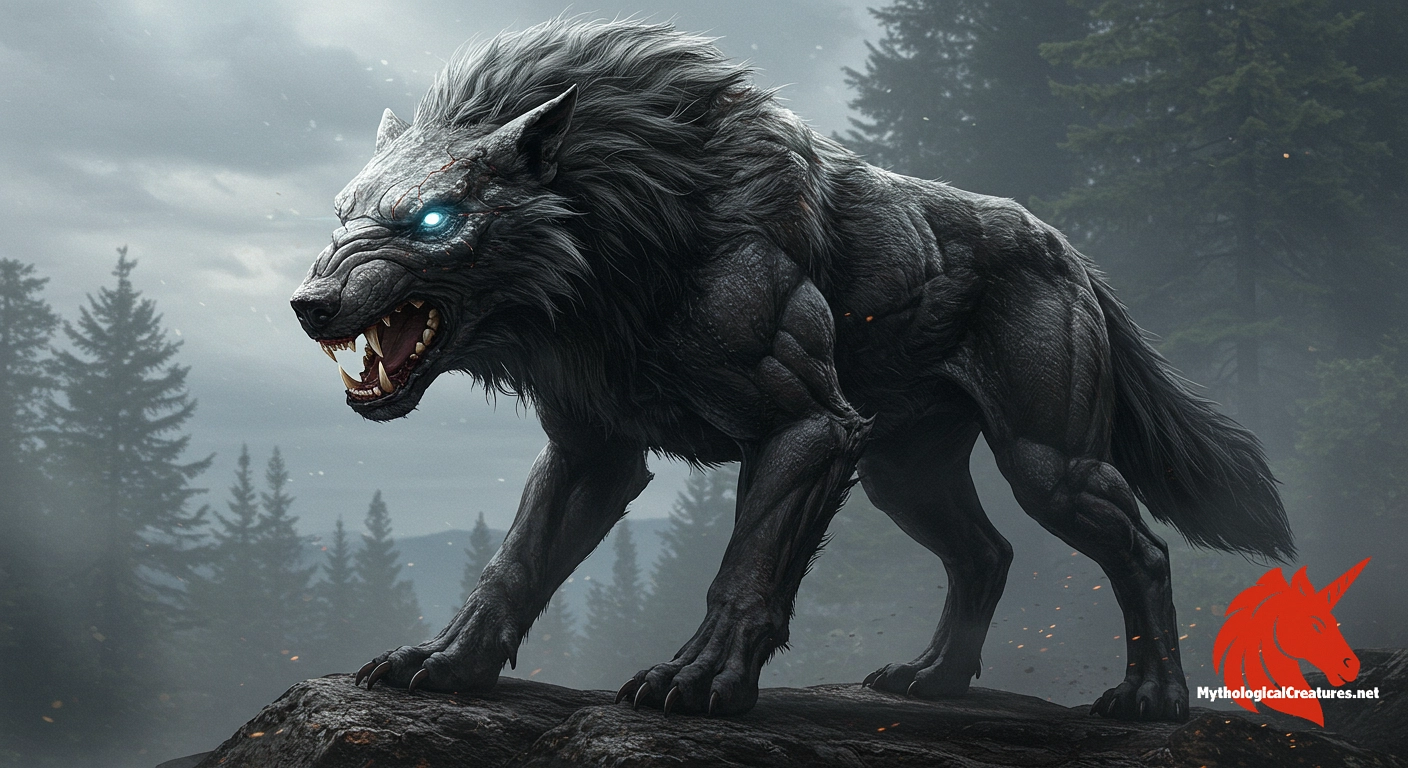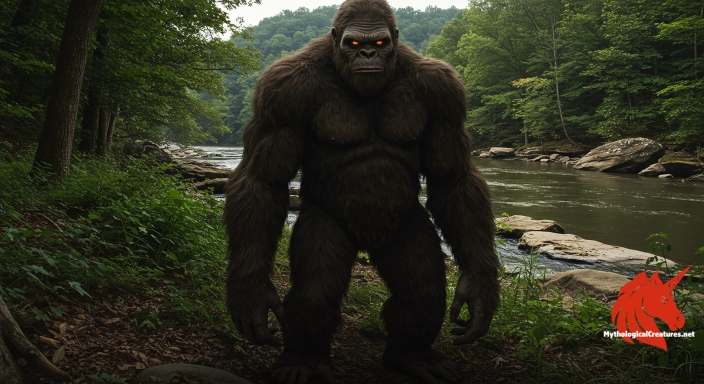Fenrir: Fenrir is a monstrous wolf from Norse mythology prophesied to bring about the downfall of the gods during Ragnarök.

Fenrir
Fenrir - Fenrir embodies the inevitable chaos that leads to the downfall of the divine order, playing a central role in the eschatological events of Norse mythology.
Origins & First Encounters
Fenrir is one of the most formidable figures in Norse mythology, a monstrous wolf whose destiny is intertwined with cosmic destruction and renewal.
Born of the trickster god Loki and the giantess Angrboða, his origins are steeped in the enigmatic forces of both divine mischief and ancient chaos.
His earliest attestation appears in medieval compilations where his fate is sealed as a harbinger of Ragnarök, the end of the world for the gods.
Within the cultural tapestry of early Norse society, Fenrir symbolised the uncontrollable forces of nature and the inevitability of fate.
His lineage and actions resonate with the themes of predestination and conflict that were central to Norse beliefs.
Fenrir’s role in the mythic narrative, particularly his foretold slaying of Odin, underscores the tension between order and chaos in ancient cosmology.
The portrayal of his character has been a medium to explore both human and divine vulnerabilities in the face of unstoppable natural power.
Myth-makers crafted his narrative to reflect the complexities of a world where even the gods are subject to tumultuous change and ultimate downfall.
Source Texts & Tale Variants
The primary chronicles of Fenrir’s tale are found within the Poetic Edda and the Prose Edda, texts compiled during the medieval period that capture the essence of Norse myth.
These sources provide a rich tapestry of poetic imagery and narrative fragments that have long fueled the fascination with this fearsome wolf.
The Poetic Edda offers lyrical accounts that emphasise the ominous role Fenrir plays in the eventual breakdown of divine order.
Meanwhile, the Prose Edda not only recounts his prophesied destiny but also details the gods’ attempts to contain his rapid growth, including the noted binding which left its mark on the deity Týr.
Additional narrative layers can be found in Heimskringla, where historical storytelling blends with myth to underscore the creature’s impact on divine succession.
Other later medieval chronicles and skaldic verses also contribute to the mosaic of his narrative, each adding variations in tone and focus.
Fragments of folklore and artistic depictions across the Norse world further testify to his enduring presence in regional storytelling.
These varied accounts highlight not only a single myth but a complex tradition of storytelling that has allowed Fenrir’s character to evolve over centuries.
Form & Powers
Depictions of Fenrir portray him as an extraordinarily large and imposing wolf, his physical presence magnified to mythical proportions.
His muscular build and powerful stance render him a symbol of raw, untamed strength that dwarfs that of ordinary wolves.
The creature’s coat is often imagined as a dark, shadowy mantle, sometimes interwoven with hints of spectral light that seem to capture the very essence of doom.
His eyes are frequently described as burning with an inner fire, reflecting a depth of uncanny intelligence and fierce wrath.
The structure of his massive jaws and elongated fangs is designed to evoke a sense of impending violence, capable of inflicting profound harm.
Artistic representations occasionally emphasise rugged, scarred features that tell a story of countless battles with divine and mortal foes alike.
The sheer scale and vigour of Fenrir’s form have led artists to portray him as a creature almost beyond mortal comprehension, an embodiment of nature’s untameable ferocity.
The variance in his size and build, as recorded in different sagas and artistic impressions, further underscores his role as an ever-evolving symbol within the mythic imagination.
Regional Faces
Across the Norse cultural sphere, regional interpretations of Fenrir vary widely, reflecting local traditions and the unique landscapes of Scandinavia.
In parts of Iceland and Norway, Fenrir is presented not only as a harbinger of doom but also as a necessary counterforce to the established order of the gods.
Local folklore often imbues his character with additional symbolic layers, linking him to the wild and unbridled forces of nature that shape the harsh northern environment.
In some regions, he has been seen as a metaphor for inevitable change, mirroring the seasonal cycles and turbulent weather patterns.
Other local adaptations have played with the duality of his ferocity, sometimes portraying him as an honourable creature bound by the strict laws of fate.
Variations in his narrative can also be found in regional art and runic inscriptions, where his features may be softened or emphasised according to local aesthetic and spiritual preoccupations.
This regional diversity in storytelling highlights how the myth of Fenrir could be adapted to speak to different community values and existential concerns.
Ultimately, these local interpretations underscore how myth and landscape can merge, forming a unique tapestry that reinforces the enduring legacy of Fenrir among the Norse peoples.
Cultural Parallels
Fenrir can be seen as part of a broader archetype of monstrous canines that emerge in various mythologies, serving as symbols of chaos and the untamable forces of nature.
In Greek mythology, for example, creatures like Cerberus occupy a similar role as guardians of liminal spaces, bridging the world of the living and the realm of the dead.
Comparable images also surface in Celtic legends, where formidable hounds and spectral canines evoke the raw power of nature and fate.
In contrast with the protective roles seen in some traditions, Fenrir’s narrative highlights antagonism and the inevitable confrontation with divine order.
The symbolism of the wolf in various cultures often encompasses both nobility and savagery, reflecting a dual character that is echoed in Fenrir’s story.
These cross-cultural parallels invite a comparative analysis that reveals common human concerns about balance, power, and the boundary between civilization and wilderness.
Furthermore, modern reinterpretations in literature sometimes blend these motifs, casting Fenrir alongside other legendary beasts as embodiments of inexorable destiny.
This broader framework of mythological wolves enriches our understanding of Fenrir, situating him within an international dialogue about chaos, nature, and the divine.
Legacy & Modern Evolution
The evolution of Fenrir’s myth mirrors the changes in cultural attitudes towards chaos and nature from the ancient past to contemporary times.
Over the centuries, his image has transitioned from a fearsome herald of Ragnarök to a complex symbol admired in modern literature and art.
In modern popular culture, Fenrir has been adapted into various media including novels, films, and even video games, where his character is often reimagined with modern thematic twists.
This evolution reflects a growing fascination with mythic archetypes, and how ancient symbols can be repurposed to explore modern existential dilemmas.
Contemporary artists and storytellers frequently draw on Fenrir’s legendary traits to evoke the persistent conflict between order and chaos in an ever-changing world.
The reinterpretation of his narrative has allowed for a multiplicity of portrayals, from tragic anti-hero to relentless force of nature, thereby expanding his cultural resonance.
His enduring legacy is also evident in the musical and visual arts, where depictions of Fenrir convey both the beauty and terror of the wild.
Thus, Fenrir has transcended his mythological beginnings, evolving into a potent symbol that continues to inspire and provoke debate in modern times.
Interesting Fact
Intriguingly, despite being one of the most feared creatures among the gods, Fenrir’s destiny is seen not merely as malevolence but as an essential force that catalyses the cosmic renewal inherent in Ragnarök.
Quick Creature Info
Origin:
Associations:
Our Mythic Legendary Rating:

Also Sometimes Known As:
Habitat:
Supernatural Powers:
Physical Attributes:
Abilities:
Behavior:
Lore:
References
Discover Another Mythical Legend You May Not Have Heard Of?
Uncover the mysteries of ancient folklore and expand your knowledge of legendary beings from cultures around the world.
Dare to Meet the Hillbilly Beast of Kentucky....
Mythical Disclaimer: The images and data on this site are derived from various historical and literary sources, but we have found that many myths often have multiple versions and interpretations across references, sometimes contradictory. As a result, these creature depictions are artistic interpretations—imaginative blends of folklore, legend, and a dash of AI guesswork. Because creature descriptions vary widely, our illustrations and accompanying information represent our best effort to honor mythology while bridging creative gaps. Enjoy these interpretations—just remember, we've done our best to respect the stories and validate available data, but in the realm of mythology, details often shift, imagination leads the way, and nothing is ever set in stone!
Curated by the Mythological Creatures Team (rev. May 2025)
